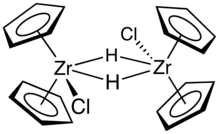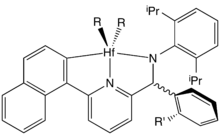Organozirconium chemistry

Organozirconium compounds are organometallic compounds containing a carbon to zirconium chemical bond. Organozirconium chemistry is the corresponding science exploring properties, structure and reactivity of these compounds.[2] In general organozirconium compounds are stable and non-toxic. They are used in organic chemistry as an intermediate in the synthesis of chemical compounds and share characteristics with organotitanium compounds also a Group 4 element. Organozirconium compounds have been widely studied, in part because they are useful catalysts in Ziegler-Natta polymerization.
The first organozirconium compound discovered (1953) was zirconocene dibromide,[3] belongs to the metallocene family. It was prepared in a reaction of the cyclopentadienyl magnesium bromide and zirconium(IV) chloride. Zirconocenes are used as polymerization catalysts; their use partly replaced traditional heterogeneous Ziegler-Natta catalysts.
Zirconium hydrides and hydrozirconation
Cp2ZrH2 was obtained in 1966 by the reaction of (Cp)2Zr(BH4)2 with triethylamine.[4] In 1970 the related hydrochloride (now called Schwartz's reagent) was obtained by reduction of zirconacene dichloride (Cp2ZrCl2) with lithium aluminium hydride (or the related LiAlH(t-BuO)3).[5] They went on to investigate the reaction of these novel hydrides with carboxylic acids[6] (for example to compounds like CpZr(OCOR)3) and in 1971 then arrived at their reactions with alkynes.[7]
Schwartz's reagent ([Cp2ZrHCl]2) was subsequently found to participate in hydrozirconation, which enjoys with some use in organic synthesis. Substrates for hydrozirconation are alkenes and alkynes. With terminal alkynes the terminal vinyl zirconium product predominates. Secondary reactions are nucleophilic additions, transmetalations,[8] conjugate additions,[9] coupling reactions, carbonylation and halogenation.

Zirconocyclisation
Zirconocene dichloride can be used to cyclise enynes and dienes to give cyclic or bicyclic aliphatic systems.[10][11][12][13]
Organohafnium chemistry
Organohafnium compounds behave nearly identically to organozirconium compounds. Many Hf analogues of Zr compounds are known, including bis(cyclopentadienyl)hafnium(IV) dichloride, bis(cyclopentadienyl)hafnium(IV) dihydride, and dimethylbis(cyclopentadienyl)hafnium(IV).

Cationic hafnocene complexes, post-metallocene catalysts, are used on an industrial scale for the polymerization of alkenes.[15][16]
See also
- Other chemistries of carbon with other elements in the periodic table.
| Compounds of carbon with other elements in the periodic table | |||||||||||||||||||||||||||||||||||||||||||||||||||||||||||||||||||||||||||||||||||||||||||||||||||||||||||||||||||||||||||||||||||||||||||||||||||||||||||||||||
|---|---|---|---|---|---|---|---|---|---|---|---|---|---|---|---|---|---|---|---|---|---|---|---|---|---|---|---|---|---|---|---|---|---|---|---|---|---|---|---|---|---|---|---|---|---|---|---|---|---|---|---|---|---|---|---|---|---|---|---|---|---|---|---|---|---|---|---|---|---|---|---|---|---|---|---|---|---|---|---|---|---|---|---|---|---|---|---|---|---|---|---|---|---|---|---|---|---|---|---|---|---|---|---|---|---|---|---|---|---|---|---|---|---|---|---|---|---|---|---|---|---|---|---|---|---|---|---|---|---|---|---|---|---|---|---|---|---|---|---|---|---|---|---|---|---|---|---|---|---|---|---|---|---|---|---|---|---|---|---|---|---|
| |||||||||||||||||||||||||||||||||||||||||||||||||||||||||||||||||||||||||||||||||||||||||||||||||||||||||||||||||||||||||||||||||||||||||||||||||||||||||||||||||
References
- ↑ Ewen, J. A.; Jones, R. L.; Razavi, A.; Ferrara, J. D. (1988). "Syndiospecific propylene polymerizations with Group IVB metallocenes". Journal of the American Chemical Society. 110: 6255–6256. doi:10.1021/ja00226a056.
- ↑ A. Maureen Rouhi (19 April 2004). "Organozirconium Chemistry Arrives". Chemical & Engineering News. 82 (16): 36–39. doi:10.1021/cen-v082n015.p035. ISSN 0009-2347.
- ↑ G. Wilkinson; P. L. Pauson; J. M. Birmingham; F. A. Cotton (1953). "Bis-cyclopentadienyl derivatives of some transition elements". Journal of the American Chemical Society. 75 (4): 1011–1012. doi:10.1021/ja01100a527.
- ↑ James, B. D.; Nanda, R. K.; Walbridge, M. G. H. (1967). "Reactions of Lewis bases with tetrahydroborate derivatives of the Group IVa elements. Preparation of new zirconium hydride species". Inorganic Chemistry. 6 (11): 1979–1983. doi:10.1021/ic50057a009.
- ↑ Wailes, P. C.; Weigold, H. (1970). "Hydrido complexes of zirconium I. Preparation". Journal of Organometallic Chemistry. 24 (2): 405–411. doi:10.1016/S0022-328X(00)80281-8.
- ↑ Wailes, P. C.; Weigold, H. (1970). "Hydrido complexes of zirconium II. Reactions of dicyclopentadienylzirconium dihydride with carboxylic acids". Journal of Organometallic Chemistry. 24 (2): 413–417. doi:10.1016/S0022-328X(00)80282-X.
- ↑ Wailes, P. C.; Weigold, H.; Bell, A. P. (1971). "Hydrido complexes of zirconium". Journal of Organometallic Chemistry. 27 (3): 373–378. doi:10.1016/S0022-328X(00)82168-3.
- ↑ "Allylic alcohols by alkene transfer from zirconium to zinc: 1-[(tert-butyldiphenylsilyl)oxy]-dec-3-en-5-ol". Organic Syntheses. 9 (74): 205. 1998. Retrieved 2013-03-23.
Organic Syntheses, Coll. Vol. 9, p.143 (1998); Vol. 74, p.205 (1997).
- ↑ Conjugate Addition Of A Vinylzirconium Reagent: 3-(1-Octen-1-Yl)Cyclopentanone, Organic Syntheses, Coll. Vol. 9, p.640 (1998); Vol. 71, p.83 (1993).
- ↑ Fillery, Shaun F.; Richard J. Whitby; George J. Gordon; Tim Luker (1997). "Tandem reactions on a zirconocene template" (PDF). Pure and Applied Chemistry. 69 (3): 633–638. doi:10.1351/pac199769030633. Retrieved 2013-03-23.
- ↑ Kasatkin, A.; Whitby, R. J. (1999). "Insertion of 1-Chloro-1-lithioalkenes into Organozirconocenes. A Versatile Synthesis of Stereodefined Unsaturated Systems". Journal of the American Chemical Society. 121 (30): 7039–7049. doi:10.1021/ja9910208.
- ↑ "Zirconium-promoted Bicyclization of Enynes". Comprehensive Organic Synthesis. 1991. pp. 1163–1184. doi:10.1016/B978-0-08-052349-1.00149-9. ISBN 978-0-08-052349-1.
- ↑ Whitby, R. J.; Dixon, S.; Maloney, P. R.; Delerive, P.; Goodwin, B. J.; Parks, D. J.; Willson, T. M. (2006). "Identification of Small Molecule Agonists of the Orphan Nuclear Receptors Liver Receptor Homolog-1 and Steroidogenic Factor-1". Journal of Medicinal Chemistry. 49 (23): 6652–6655. doi:10.1021/jm060990k. PMID 17154495.
- ↑ Thomas, E.; Dixon, S.; Whitby, R. J. (2006). "A Rearrangement to a Zirconium–Alkenylidene in the Insertion of Dihalocarbenoids and Acetylides into Zirconacycles". Angewandte Chemie International Edition. 45 (42): 7070–7072. doi:10.1002/anie.200602822. PMID 17009379.
- ↑ Chum, P. S.; Swogger, K. W., "Olefin Polymer Technologies-History and Recent Progress at the Dow Chemical Company", Progress in Polymer Science 2008, volume 33, 797-819. doi:10.1016/j.progpolymsci.2008.05.003
- ↑ Klosin, J.; Fontaine, P. P.; Figueroa, R., (2015). "Development of Group Iv Molecular Catalysts for High Temperature Ethylene-Α-Olefin Copolymerization Reactions". Accounts of Chemical Research. 48: 2004–2016. doi:10.1021/acs.accounts.5b00065.
